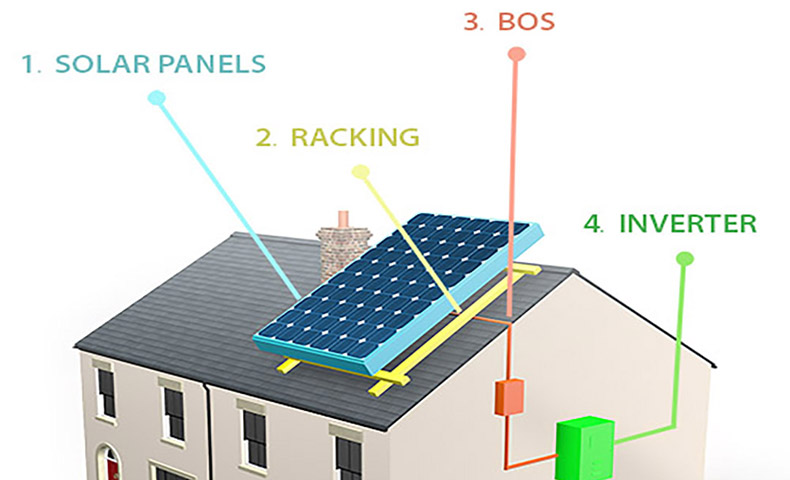
Whenever you hire an installer to work on your home solar energy system, the contractor will conduct an evaluation of your electricity usage so that he can recommend an installation that matches those energy needs.
This can also be easily factored through the Hahasmart price checker that will provide you with the correct size of your solar power system. Just provide your address and your average monthly utility bill and you’ll get the actual price of solar panels and inverters - which are the most critical parts of a solar powered system - as well as provide you with an estimated cost of installation based on thousands of completed solar projects in your area.
They’ll even provide you with an estimated buyback period, the point where the electricity savings achieved with your solar array cover the purchase of your residential solar panels and your system becomes free.In addition, they’ll connect you with their installer network to get your residence equipped with solar power as possible.
Interconnection
Before you can install your residential solar panels, your utility must first approve it, explains Solar United Neighbors. Your installer will submit the preliminary interconnection paperwork with your utility on your behalf, making sure the size and location of the solar array is approved by the utility. Once the array is installed, your local jurisdiction will inspect it and your installer will submit a request for interconnection to your utility. Interconnection is the process through which your utility connects your solar array into their grid, allowing for the flow of power between the two. Once approved, your utility will visit the installation and install a two-way meter, which allows for more accurate reading and reporting of your solar electricity production. Once the two-way meter is installed and your utility gives you formal “permission to operate,” you can flip the switch on your solar array.
Once those panels are turned on and start generating power, you’ll start saving on your electricity bill in two ways. One is that you’ll be buying less power from grid and two, you’ll be sending the extra power you generate to the electric company.
But don’t think solar panels can be directly connected to the grid to send the power back.
That job belongs to the solar inverter, which converts the DC power generated by your solar panels into AC power that your appliances use. The inverter will be analyzing how much power you need at any one point. Whatever is left goes to the grid. As the inverter converts the DC from the solar panels into the AC, it also decides whether to use the generated power to run the appliances in your home or to feed into the grid. The system operates automatically and switching between the supplies is so rapid that the user cannot realize any jitters in the working of their appliances.
“The excess power is fed into the grid by the principle of electrical impedance. Electrical Impedance is the measure of voltage to current ratio in an AC circuit. In other words, impedance inhibits current flow between two points in an AC electric circuit. And again the net meter installed at the user’s premises can register the amount of current flow,” explains insolergy.com.
Excess power
Your domestic solar power system generates electricity as long as there is sunshine falling on your panels. That means they’ll be generating throughout the day.
If the installation matches your energy consumption, you’ll be producing more electricity than you can use during the day, when usage tends to be lower because you’ll be working or out of the house. This is called net metering.
Electricity generated from your panels will first be used by your home. But if a grid-connected system is producing more power than the home consumes, the surplus is fed into the power grid. Some electricity companies meter the electricity fed into the grid by your system and provide a credit on your bill in exchange for the electricity you purchase from them at night. They determine how much you’re compensated for this power, which is then distributed to your neighbors and the rest of the utility customers.
If you use more electricity than your system feeds into the grid during a given month, you pay your power provider only for the difference between what you used and what you produced.
Some people who are able to lower your electricity usage to match what they get from the grid can achieve net-zero energy, balancing out what they get and what they put out in terms of electricity. That will ensure you only pay for connection and maintenance fees, which are only a fraction of your total power bill.
HahaSmart Blog - More Solar Tips and Guide
HahaSmart News - Stay Informed
Your Solar Incentives - See Credits and Incentives in Your Area
Check Your Home's Solar Price - See How Much You Save
Register Now - Unlock The Lowest Solar Prices in Your Area


Input your address to see if it is solar friendly and how much you can save with solar.
Great. Your address is perfect for solar. Solar incentive is still available. Select monthly utility cost and calculate the size of solar system you will need now.
| kw System size | years Payback period | Lifetime savings |
No money down, 100% finance is available.
|
|
Want to join the renewable energy revolution? Sign up to receive a solar power system quote today |
Comments